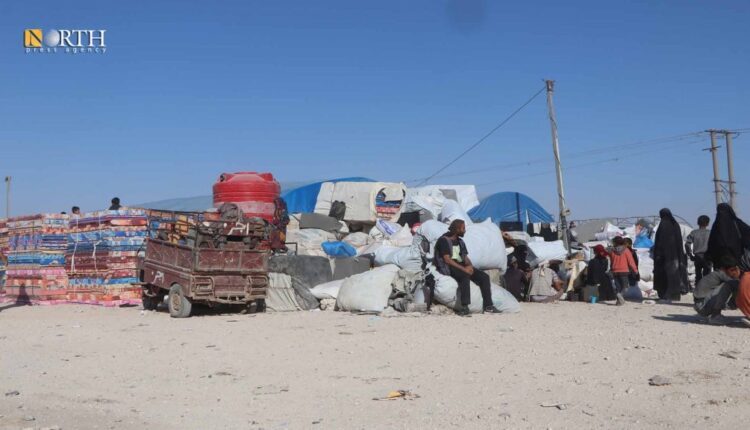
By Iman al-Nasser
DEIR EZ-ZOR, Syria (North Press) – For four years in Hawl Camp in the southeast of Hasakah, northeastern Syria, Fawzia al-Khedr tirelessly searched for someone to help her leave the camp to return to Deir ez-Zor Governorate, eastern Syria. Eventually, a tribal leader mediated for her departure.
Al-Khedr, 36, originally from Deir ez-Zor, left the Hawl Camp and is initially settled in the eastern countryside of Deir ez-Zor. However, the unstable security state and scarce job opportunities compelled her to relocate to the western countryside of Deir ez-Zor in the village of al-Mashhur.
Al-Khedr, who left the camp a year ago, told North Press that a tribal leader mediated and helped her to leave the camp.
The camp houses 55,000 individuals, including 28,725 Iraqis, about 18,641 Syrians from various governorates and 8,803 of foreign nationalities, according to the latest statistics obtained by North Press.
After leaving the camp, al-Khedr rented a house in the eastern countryside of Deir ez-Zor. The locals there assisted her by paying her rent and providing financial support.
For security reasons, she moved to the western countryside of Deir ez-Zor, where she received help from the neighbors and worked as a daily laborer in agriculture to secure her daily expenses.
The situation of thousands of Syrian families is similar to that of al-Khedr as they remain in the camp. The majority of its residents lost identification papers, which complicates the procedures of their departure as the Autonomous administration of North and East Syria (AANES) maintains strict measures for departing the camp due to security reasons.
Typically, residents of the camp can leave with the mediation of tribal leaders from their original areas. Alternatively, the AANES may assist individuals with unique cases, particularly those with chronic illnesses, by facilitating their departure procedures.
Specific clause
On Oct. 22, Deir ez-Zor Civil Council affiliated with the AANES, in cooperation with the Syrian Democratic Council (SDC), held a conference under the title ‘Enhancing Security and Stability towards Development and Consolidation of Cooperation in Deir ez-Zor’ to discuss the political, economic, security and social situation in Deir ez-Zor.
One of the outcomes of the conference had a specific clause that stated to orderly and periodically evacuation of families that hail from Deir ez-Zor residing in Hawl Camp.
The conference was convened to fulfill promises made by the Syrian Democratic Forces (SDF) to improve the conditions of Deir ez-Zor’s residents and address their demands following the security tensions that occurred in late August and early September.
At the time, the countryside of Deir ez-Zor witnessed tension and clashes that erupted between the SDF and armed groups affiliated with the Syrian government forces and Iranian-backed militias.
Amina Omar, co-chair of the SDC which is the political wing of the SDF, told North Press in a previous statement that the aim of the planned attacks was to spread chaos and sectarian tension among the population, as well as to incite Arab tribes against the AANES.
Public demands
The process of evacuating families from the camp was primarily carried out through the mediation of tribal notables, says Saleh Abdurrahman, a civil rights activist from the village of Hammar al-Ali in the west of Deir ez-Zor.
The evacuation of the families was based on demands of the people of Deir ez-Zor, Abdurrhaman said. There are ongoing efforts to increase the number of evacuated people, he added.
The people who leave the camp are primarily residents from the AANES-held areas, making their evacuation and reintegration relatively smoother. The challenge, however, lies in evacuating families from government-held areas, according to Abdurrahman.
He noted that the integration of these families is more difficult due to societal perceptions because they are not from the area and the community has a generally negative perception towards them.
Saddam al-Aboud, an administrator at the IDPs and Camps Affairs Office of the AANES in Deir ez-Zor, told North Press that after the AANES issued the decision to evacuate families, they proposed a project to the NGOs to provide assistance for those leaving the camp.
The project consists of five points, including setting up a reception center for the IDPs, providing transportation to the center, and then transferring them to the designated places of residence.
Additionally, the project includes providing logistic support to the reception center. It highlights the importance of creating a record of the IDPs, documenting their residence, the number of families and individuals, and identifying pregnant women and those with special needs.
Al-Aboud also said the duration of their stay at the reception center is limited to a maximum of ten days.
